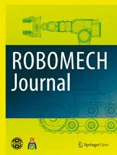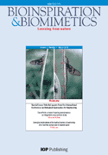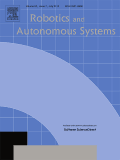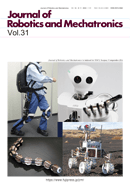
Soft Robotics
Scope & Guideline
Unveiling the Potential of Soft Materials in Robotics.
Introduction
Aims and Scopes
- Soft Actuation Mechanisms:
Research focuses on developing novel actuation methods, including pneumatic, hydraulic, electroactive, and hybrid systems that allow soft robots to achieve complex movements and interactions. - Biomimetic Design:
The journal highlights studies inspired by biological systems, exploring how natural organisms' functions and structures can inform the design of soft robotic systems. - Adaptive Materials and Structures:
Emphasis is placed on the use of advanced materials, such as hydrogels, elastomers, and composites, to create robots that can change their properties dynamically, enhancing their functionality. - Control Strategies for Soft Robots:
Research includes the development of control algorithms, including machine learning approaches, that enable soft robots to interact effectively with their environments. - Applications in Healthcare and Rehabilitation:
The journal covers applications of soft robotics in medical fields, including rehabilitation devices, surgical tools, and assistive technologies for individuals with disabilities. - Environmental Interaction and Navigation:
Studies address how soft robots can navigate and manipulate in unstructured environments, including underwater exploration, agriculture, and disaster response.
Trending and Emerging
- Integration of Sensing Technologies:
There is a growing focus on integrating advanced sensing capabilities into soft robots, enabling them to perceive their environments more effectively and interact in more sophisticated ways. - Machine Learning and AI in Robotics:
The application of machine learning and artificial intelligence for control and decision-making in soft robotics is rapidly increasing, facilitating more autonomous and intelligent robotic systems. - Wearable Robotics and Assistive Devices:
An emerging trend is the development of soft wearable robotics designed for rehabilitation and assistance, targeting enhanced user interaction and therapeutic outcomes. - Multimodal Robotic Systems:
Research is trending towards multimodal systems that can operate across various environments and tasks, such as combining swimming and crawling capabilities in a single robot. - Sustainability and Biodegradable Materials:
An increasing number of studies are focusing on sustainable practices and the use of biodegradable materials in soft robotics, addressing environmental concerns associated with robotics. - Soft Robotics for Medical Applications:
The application of soft robotics in medical fields is on the rise, particularly in minimally invasive surgical tools, rehabilitation devices, and prosthetics, highlighting the field's potential impact on healthcare.
Declining or Waning
- Static Soft Robotics Systems:
Research on purely static soft robotics—robots that do not incorporate dynamic movement or actuation—has decreased as the field shifts towards more dynamic and interactive systems. - Conventional Control Systems:
There is a notable decline in studies focusing solely on traditional control methods, as newer adaptive and learning-based control strategies gain prominence. - Basic Material Studies:
Publications centered around fundamental material properties without direct application to robotics have waned, as research becomes more application-oriented and interdisciplinary. - Single-Function Robots:
The trend is moving away from soft robots designed for single, isolated tasks to more complex, multifunctional systems capable of adapting to various environments and tasks.
Similar Journals

Journal of Micro-Bio Robotics
Bridging Robotics and Biology for Tomorrow's SolutionsThe Journal of Micro-Bio Robotics, published by SPRINGER HEIDELBERG, is an esteemed periodical dedicated to the dynamic intersection of robotics and biological systems. With an ISSN of 2194-6418 and an E-ISSN of 2194-6426, this journal spans a broad spectrum of interdisciplinary research from 2013 to 2024, reflecting its commitment to advancing knowledge in fields such as biomedical engineering, biotechnology, electrical and electronic engineering, materials science, and mechanical engineering. This journal holds a Q4 ranking in Biomedical Engineering and a Q3 ranking in several other critical categories, demonstrating its growing influence within the scientific community. The journal serves as a vital resource for researchers, professionals, and students aiming to explore cutting-edge developments in micro-bio robotics, providing a platform for high-impact research that helps facilitate innovation and collaboration in this emerging field. While currently not offering Open Access options, the journal's rigorous peer-review process ensures the highest quality of published work, making it an essential tool for anyone looking to stay abreast of advancements in micro-bio robotic technology.

Frontiers in Robotics and AI
Elevating Research Standards in Robotics and AIFrontiers in Robotics and AI is a leading journal dedicated to the exploration and dissemination of groundbreaking research in the fields of robotics and artificial intelligence. Published by FRONTIERS MEDIA SA in Switzerland, it has established itself as a vital resource for academics, professionals, and students since its inception in 2014. With an impressive Open Access model, the journal ensures that high-quality research is accessible to a global audience, fostering collaboration and innovation. The journal is recognized for its distinguished impact in the academic community, achieving Q2 quartile rankings in both Artificial Intelligence and Computer Science Applications as of 2023. It currently holds a solid position in Scopus rankings, with a rank of #123 out of 350 in Artificial Intelligence and #223 out of 817 in Computer Science Applications, reflecting its robust contribution to these dynamic disciplines. The journal's scope encompasses a wide range of topics, including but not limited to autonomous systems, machine learning, and human-robot interaction, making it an essential platform for innovative ideas and advanced research.

ROBOMECH Journal
Fostering Collaboration and Knowledge Sharing in RoboticsROBOMECH Journal, published by SpringerNature, is a prominent open-access journal dedicated to the fields of robotics, mechanical engineering, and artificial intelligence. Established in 2014, the journal has quickly established itself as a vital platform for disseminating innovative research in control and optimization, instrumentation, and modeling and simulation, earning a commendable Q2 ranking in Mechanical Engineering and multiple Q3 rankings across other relevant fields in 2023. With a commitment to facilitating accessible knowledge sharing, ROBOMECH Journal promotes cutting-edge research that drives advancements in both theoretical frameworks and practical applications within the robotics community. Scholars, engineers, and professionals seeking to contribute to or stay informed about the latest developments in these dynamic fields will find the journal's rich array of articles invaluable. With its open-access model, all published research is freely available, ensuring wide dissemination and increased visibility for authors, thus fostering collaboration and innovation across disciplines.

Bioinspiration & Biomimetics
Emulating Nature, Advancing InnovationBioinspiration & Biomimetics is a premier journal published by IOP Publishing Ltd, specializing in the innovative study of biological inspiration across various scientific disciplines. Since its inception in 2006, this journal has been a vital platform for researchers who aim to emulate nature's processes in engineering, biochemistry, and medicine. With an impressive classification in the Q1 and Q2 quartiles across categories such as Biophysics and Engineering as of 2023, it ranks highly within the Scopus database, including a notable 81st percentile ranking in Engineering (miscellaneous). While currently not offered as an open-access publication, Bioinspiration & Biomimetics continues to deepen the understanding of biomimetic applications, encouraging interdisciplinary collaboration and innovative solutions to complex challenges in both academia and industry. Researchers and professionals seeking to drive forward the future of sustainable technologies will find this journal an invaluable resource for the latest advancements and insights in the field.

Robotic Intelligence and Automation
Transforming Ideas into Intelligent Solutions.Robotic Intelligence and Automation is a pioneering academic journal dedicated to the exploration and advancement of knowledge within the realms of robotics, artificial intelligence, and automation technologies. Published by EMERALD GROUP PUBLISHING LTD in the United Kingdom, this journal serves as a critical platform for researchers, professionals, and students who strive to understand and innovate in these rapidly evolving fields. With an impressive visibility across multiple disciplines, it has achieved a respectable Q2 ranking in Computer Science Applications, Control and Systems Engineering, Electrical and Electronic Engineering, and Industrial and Manufacturing Engineering, while also being recognized in Q3 for Artificial Intelligence and Human-Computer Interaction. The journal boasts a comprehensive Open Access model, allowing broad dissemination of research findings, which is vital for fostering collaboration and learning within the scientific community. Researchers can look forward to contributing to a publication that not only addresses current challenges but also seeks to shape the future of intelligent automation and robotics.

Advanced Intelligent Systems
Connecting Minds, Shaping Intelligent Futures.Advanced Intelligent Systems, published by WILEY, stands as a prominent Open Access journal dedicated to the interdisciplinary exploration of intelligent systems, with a focus on materials science, engineering, and computer science. Since its establishment, the journal has fostered innovative research, providing a platform for the dissemination of findings that push the boundaries of artificial intelligence, human-computer interaction, and systems engineering. Although it is relatively new, having converged from 2023 to 2024, it ranks within various Scopus categories, showcasing its growing influence in fields such as mechanical engineering and computer vision. With an emphasis on accessibility, the journal has been Open Access since 2019, ensuring that cutting-edge research is available to a global audience of researchers, professionals, and students, thus driving forward the frontiers of intelligent systems development.

ADVANCED ROBOTICS
Driving Excellence in Robotic SolutionsADVANCED ROBOTICS is a premier journal published by Taylor & Francis Ltd that has been at the forefront of robotics research since its inception in 1986. With an esteemed ISSN of 0169-1864 and E-ISSN of 1568-5535, this journal offers a unique platform for disseminating high-quality research across diverse domains within the robotics field, encompassing applications in Computer Science, Control and Systems Engineering, Hardware and Architecture. Ranked in the Q2 quartile across multiple categories in 2023, ADVANCED ROBOTICS maintains a reputable standing in the academic community, emphasizing its commitment to advancing knowledge and innovation. Although not an Open Access publication, the journal’s access options ensure that subscribers can explore the latest findings and engage with prominent experts in the field, facilitating an enriching exchange of ideas. Researchers, professionals, and students alike will find ADVANCED ROBOTICS an invaluable resource for keeping abreast of developments and contributing to the ever-evolving landscape of robotics.

ROBOTICS AND AUTONOMOUS SYSTEMS
Pioneering Research for Tomorrow's Autonomous Systems.ROBOTICS AND AUTONOMOUS SYSTEMS, published by Elsevier, is a leading journal in the fields of robotics and automation, providing a platform for the dissemination of high-quality, peer-reviewed research. With an impressive impact factor and a prestigious reputation, this journal is classified in the Q1 category for major fields including Computer Science Applications, Control and Systems Engineering, Mathematics, and Software as of 2023. The journal boasts an extensive archive dating back to 1988, reflecting the evolution of the discipline and fostering innovative research discussions that are crucial for advancements in autonomous technologies. Researchers, professionals, and students are encouraged to contribute to and benefit from the ongoing dialogue within these dynamic fields. Accessible through various academic resources, ROBOTICS AND AUTONOMOUS SYSTEMS stands as a pivotal information source for those dedicated to exploring the frontiers of intelligent systems.

Journal of Robotics and Mechatronics
Exploring New Frontiers in Mechanical SystemsJournal of Robotics and Mechatronics, published by FUJI TECHNOLOGY PRESS LTD, stands at the forefront of innovation in the fields of robotics and mechatronics. Since its inception in 1989, this Open Access journal has become a vital resource for researchers, professionals, and students interested in advances that merge technology with mechanical systems, offering critical insights into practical applications and theoretical developments. With a commendable impact factor reflected in its Q2 rankings in both Computer Science (miscellaneous) and Electrical and Electronic Engineering, the journal serves as a platform for disseminating high-quality research and fostering academic collaborations. The journal enjoys wide accessibility since transitioning to Open Access in 2007, allowing for a global audience to engage with groundbreaking findings relevant to both industry and academia. Based in Tokyo, Japan, the Journal of Robotics and Mechatronics aspires to bridge the gap between research and practical implementation, encouraging the exploration of novel concepts and the sharing of scientific knowledge.

Micro and Nano Systems Letters
Pioneering Research at the Micro and Nano ScaleMicro and Nano Systems Letters, published by SPRINGERNATURE, is a prominent peer-reviewed journal dedicated to advancing the field of micro and nanosystems, with a special focus on biomaterials and biomedical engineering. Since its inception in 2013, this Open Access journal has provided a vital platform for researchers and practitioners to disseminate innovative findings and share insights that contribute to the growing body of knowledge in these rapidly evolving disciplines. With a remarkable impact reflected in its Q1 quartile rankings in both biomaterials and biomedical engineering, and impressive Scopus ranks placing it within the top tier of its fields, Micro and Nano Systems Letters plays a critical role in fostering collaboration and knowledge exchange among scientists and engineers worldwide. The journal is accessible globally, ensuring that research is widely disseminated and impacting a diverse audience to drive progress in technology and healthcare solutions.